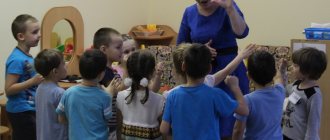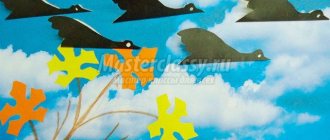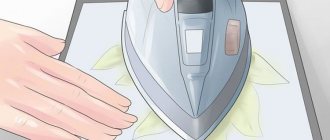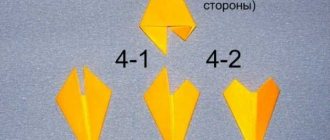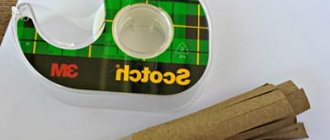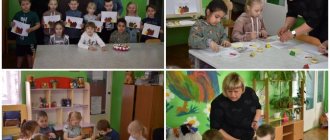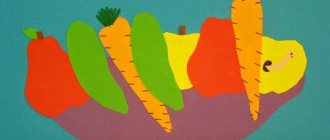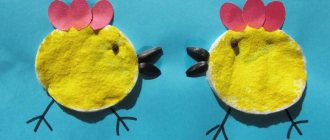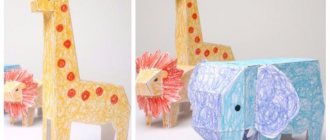Features of preparing and conducting a lesson on the “Round Dance” application
When planning a lesson on application in the preparatory group of a preschool educational institution, the teacher is guided by the requirements of the program, and they are quite high for children of this age.
Program requirements for children's skills and abilities
According to the exemplary educational program “Origins”, developed in accordance with the Federal State Educational Standard, children of the seventh year of life:
- create works of artistic value and applied significance (collages, panels, friezes, posters, wall newspapers, illustrations, postcards, invitation cards, bookmarks), acting individually or in collaboration with other people (children and adults);
- continue to master new methods of curvilinear cutting: symmetrical, pair-symmetrical, ribbon, silhouette (along a drawn or imaginary contour), applied applique for obtaining multi-color images, slotted decor for making openwork products (snowflake, flowerpot, napkin, curtain, clothes for dolls, masks and scenery for theatrical productions);
- freely combine mastered methods, combine appliqué techniques with various techniques of decorative drawing, artistic design, and children's design.
Theme options
With proper preparation and organization, an application on the theme “Round Dance” allows the teacher to carry out a significant number of the listed tasks.
A round dance can not only be danced, but also made in the form of an applique
Planning, as we know, begins with choosing a topic. “A festive round dance” in the minds of many adults is associated with the New Year, but those who work with children know that such applications can be timed to coincide with any occasion, given that a round dance is a mass ritual dance that accompanied any holiday among the ancient Slavs .
A round dance is a kind of symbol of beauty - the beauty of movement, the beauty of the surrounding world and, finally, human beauty. The main structure of the round dance is a circle, its circular composition (similar to the sun) and movement in the direction of the sun (walking after the sun - “posolon”) originate from ancient pagan rituals and games of the Slavs, who worshiped the powerful sun god.
Alexander Morgan
Article “Slavic culture. Round dance"
The subject of the application can be different, in particular:
- “Round Dance of Friendship” dedicated to National Unity Day;
- "Spring", marking the beginning of spring;
- “Autumn” - in honor of the harvest festival;
- “Rainbow”, which is appropriate when studying the colors of folk costumes;
- “New Year” on the eve of the winter holidays;
- "Birthday";
- fantasy (dolls, forest animals, snowmen, fish, Christmas trees, that is, characters who can only participate in an imaginary round dance).
Photo gallery: options for the “Round Dance” application (festive, friendship, Russian beauties, etc.)
The “Round Dance of Friendship” collage will introduce children to the culture of other countries
The application “Round Dance of Russian Beauties” will introduce children to the national costume
Round dance of Christmas trees made using ribbon technique
You can also use collage pictures to create a round dance.
The smaller the figurine size, the more difficult it is to “dress” and “undress” this figurine.
A round dance does not always mean little men, it can be rays of sunshine
A round dance of bunnies around the Christmas tree can be done using cotton pads
Application "New Year's round dance" with elements of quilling and mosaic - an excellent option for a postcard
The application “Round Dance of Snowmen” with elements of paper plastic develops spatial thinking
Collective or individual form of work: when to use
Work with the application can be both individual and collective. The teacher chooses the form depending on:
- the level of preparedness of children (if there are children who are too slow or unable to keep up with their studies, then it is more convenient to do group work so that everyone can express themselves to the best of their abilities and at the same time the final result will not suffer in terms of time and quality);
- reason for making an application (if the work is the result of studying a topic, then it is better to choose an individual one - this way it is easier to track the educational results of each child; if the application is being prepared for a stand, then the form should also be individual, so that mothers and fathers can see the fruits of their handiwork children);
- techniques for performing the work (if children can handle ribbon appliqué or collage on their own, then appliqué with elements of origami, quilling, and mosaics requires much more time and effort, which means it’s easier for everyone to do it together);
- time allocated for a specific lesson by calendar-thematic planning (for example, applications with a combination of execution techniques are faster to do collectively in order to fit into one lesson). Working in pairs is of great value for developing a sense of camaraderie, the ability to negotiate the division of work and plan the result. The topic “Round Dance” is quite complex; working in pairs will bring results if children have already learned this type of cooperation in simpler ones (“Flowers in the Meadow”, “Winter City”).
Working in pairs fosters a sense of camaraderie and mutual assistance in preschoolers
Since the applique is carried out in the preparatory group and the result, according to the program requirements, should be a work of artistic value, the optimal option would be collective work (made by the whole group or in subgroups of 5-6 people) with a combination of techniques and materials.
Level of difficulty and technique of application
The more often the guys practice appliqué, the more techniques can be combined to perform the “Festive Round Dance”
Since we are talking about children 6–7 years old who have an understanding of working with fabric and cereals, the classic paper appliqué can be diversified with a combination of 2–3 execution techniques. This makes the task more difficult, but the end result is much more original.
Techniques for making applique:
- Invoice. Simple overlay of figures cut out of paper independently or according to a template in the preparatory group can be complicated by adding volume, that is, the elements of the round dance are not glued completely, but are folded and fixed against the background only at the folded points.
- Tape. The child cuts out figures of round dancers from a strip of paper (approximately 30 by 15 cm) and pastes them onto the background.
- Symmetrical. The figures are cut out according to a template from a sheet of paper folded in half and decorated with decor (clothes and hairstyles are glued on top).
- Modular. Participants in a round dance are depicted using ready-made geometric shapes.
- Quilling. Details twisted from narrow strips of paper (snowflakes, autumn leaves, sun and clouds) decorate the finished work.
- Precipitous. In this case, the silhouettes are made out with small pieces of colored paper. For the preparatory group, this technique should be complemented by other, more complex types of work. For example, in combination with fabric elements or origami.
- Collage. A favorite type of applique for children. In this case, either ready-made cuttings from magazines or postcards are used, or children draw figures of people dancing in a round dance in advance, paste them onto the background and decorate the work according to the theme.
To decorate the characters' clothes, you can use threads, confetti, corrugated paper, and candy wrappers. Fabric looks great in applique. This material can be used to decorate the costumes of the figures or to make elements surrounding the round dance (trees, grass, clouds, sun) out of it. Fabric parts should be prepared in advance, as they are difficult to cut with scissors.
Clothes for the men in the round dance can be made from candy wrappers
They complement the applique with drawing. With pencils, paints or felt-tip pens you can draw facial features and patterns on clothes (when human figures are used in a round dance), faces of animals, glare of rays, grass, clouds, New Year's beads and garlands.
Preparing the application background
The choice of background for the application depends on the technique of the work itself. If it is a simple ribbon appliqué with linear placement of elements, make the background more saturated and bright, think about what additional images will decorate it. These details (sun, clouds, trees, etc.) must be done in advance, since they are not included in the content of the lesson.
For example, it is advisable to make birch trees and Christmas trees made using the origami technique during a paper design class.
When planning an application in which the round dance is located in a circle, the teacher must take care of the size of the background and what to fill the center with. It is logical to conduct an autumn round dance around a basket with gifts from fields and gardens; a spring round dance was traditionally arranged around a birch tree with ribbons (you can use ready-made thin ribbons, they look great and enliven the composition). The globe is usually chosen as the center of the circle dance of friendship, and the New Year's one can be danced around the Christmas tree or Father Frost and the Snow Maiden.
A basket with gifts of autumn will serve as a wonderful center for an autumn round dance.
The background can be made from:
- fabric (sufficiently dense, plain or with a small, unobtrusive pattern);
- silhouettes of figures (stars, slits, etc.) superimposed on a colored background;
- cereals (such applications look very original, but require special care, since you must first glue the round dance, and only then fill in the cereal without touching the figures);
- confetti (this background is very bright, so the round dance itself should be monochromatic and dark);
- wallpaper in soft colors, with a small, discreet print;
- stickers or cut out pictures (such a collage looks very nice against the background of a plain round dance).
Noteworthy is the background using the monotype technique (a print of paint applied to film or plastic).
Children can make a background using the monotype technique together with their teacher.
Watercolor backgrounds made on wet paper look charming; they are especially suitable for seasonal themes (spring, autumn round dance). Children will be able to make them themselves by first applying water and then paint (with a sponge) to a sheet of thick paper. When the paper is dry, it is ironed.
Preschoolers can easily handle the design of a watercolor background on their own
How to motivate children to make the “Merry Round Dance” applique
Even walking and learning to walk single file can become an incentive to do appliqué in class.
Not only the final result, that is, the finished round dance, but also the course of the entire lesson depends on how motivated the children are for the task. Since the topic is very broad, you can use different techniques, and if time allows, then combine them.
Great motivation would be:
- stories about the holiday to which the application is dedicated. For example, National Unity Day, which has become a reason for celebration since 2005, that is, we are all witnesses to how the calendar has been replenished with a new public holiday);
- memories of a holiday in kindergarten, a proposal to depict it in class;
- descriptions of the rules of conducting a round dance (participants can hold each other’s hands, a scarf, a belt, although in some cultures it is not customary to openly hold hands, and also that the leader of the round dance is called a “round dance”, and the figures of the round dance are called “circle”, “carousel” ", "basket", etc.);
- looking at books or magazines with the elements of the round dance being studied (such cut-out pictures can be used as a background or part of a collage);
- stories about the history of the emergence of round dances (as a way to mark one or another stage of a person’s work activity);
- the arrival of funny characters (Petrushka, Mishka, Matryoshka) who ask children to help them arrange a fun round dance with friends;
- songs that not only entertain children, but also make them look at their meaning differently (for example, “Loaf-Loaf”);
- poems;
- display of illustrations. They must certainly be colorful, memorable, eye-catching, with characters familiar and beloved by children.
The use of colorful illustrative material will interest children
There are a lot of poetic works about round dances. The teacher should read the poem with appropriate facial expressions, joyfully, creating a festive mood.
- All the clouds gathered in a bunch and gave each other a hand, obscured the sky, and danced together in a circle. But the wind disperses them and makes it difficult to dance in circles. Apparently, the wind is very angry, the clouds are crying one by one. There is no round dance - water is dripping from the sky. The tears of the clouds are large - There are streams on the asphalt. The clouds are crying from above, turning into clouds. T. Kersten
- The flute sings tenderly, The mice dance in a circle. Music, moon, river Lulled the cat to sleep. In the silence of the night they danced until dawn. A. Kuznetsov
- As always, on New Year's Day we begin a round dance! Well, children, stood in a circle, inviting friends with them, took each other’s hands, smiled more cheerfully! Louder, stomp your foot louder! Take two steps forward, steel, clap your hands, and then vice versa! Step back! Everyone turn around! Did you forget to smile? He clapped, gave his hand to a friend, and let's go, let's go in a circle! Have fun ahead! Forward! The round dance is whirling around! Hello! Hello, long-awaited, Our beloved and desired, Good holiday - New Year! O. Konaeva
It is not necessary to read a poem about a round dance; it can be replaced with a work about friendship, autumn gifts, the beauty of spring nature. This is the choice of the teacher, and it depends on the topic of the lesson and the nature of the introductory conversation.
Structure, goals and objectives of the application lesson on the theme “Round Dance”
The lesson notes for the preparatory group are designed for 30 minutes to achieve the educational goals . During this time, the teacher must “guide” the children through 3 stages of work:
- beginning - 7 minutes (using presentations, videos, poems and stories about the history of the round dance);
- the main part - 18-20 minutes, including physical education minutes of 2-3 minutes (work on the application, with commentary on each action of the children);
- conclusion - 2–3 minutes (summarizing, discussing work with children).
The main educational goals of the lesson on the application “Festive round dance”:
- developing the ability to cut out several symmetrical parts from paper folded several times (if we are talking about an applied applique);
- work on the accuracy of movements when cutting out a figure along the contour (if we are talking about a collage);
- practicing the skill of drawing contour figures (if the kids are expected to draw elements of a round dance or outline a cardboard template).
In addition, children learn to combine colors, develop coordination of eye and hand movements, cultivate aesthetic taste, expand their horizons, learn to work individually and in a group, and get used to being responsible for the work of the entire creative group.
The tasks will vary slightly depending on the technique chosen. Thus, when making an applique from paper, special attention will be paid to repeating the rules of safe handling of scissors and the ability to combine warm and cold shades of paper.
If the craft is with origami elements, then the tasks include strengthening the skill of folding paper parts symmetrically. To apply appliqué with a fabric insert, children must master the skill of gluing soft material. When working with scraps of paper and cereal, children need to develop a sense of proportion, as well as precision in gluing the material to the base.
Abstracts of GCD in the preparatory group of preschool educational institutions
| Author and theme of GCD | Objectives and course of the lesson |
| Silvestrova O. “Rainbow round dance” | Goal: To teach children to cut out several symmetrical objects from paper folded like an accordion and in half. Tasks:
Individual work: develop hand-eye coordination and eye control. Types of activities: productive, communicative, gaming, motor, musical. Types of organization: frontal, independent. Equipment: white paper (30 by 15–20 cm); colored and white paper for practicing and cutting out a round dance, an audio recording of “Vesnyanka” by P. I. Tchaikovsky, illustrations depicting round dance games. Preliminary work: conversation and viewing illustrations about the color spectrum, about round dancing games in Rus', listening to the music of P. I. Tchaikovsky “Vesnyanka”. Progress of the lesson. To the music, children stand in a circle, each holding a colored rectangle. Questions for the introductory conversation: - A multi-colored yoke hung across the river. What is this? (rainbow). — I suggest you build a living rainbow (at the teacher’s signal, the children build a color spectrum). —What clue sentence helps us remember the rainbow colors? (Every hunter wants to know where the pheasant is sitting.) - Let's check if we built the rainbow correctly. Well done! The teacher draws the children's attention to an easel on which there are pictures depicting people in Russian folk costumes dancing in a circle: - What do you see in these pictures? (The girls stood in a circle). — What do you think the people depicted here are doing? (They dance in a circle). “Spring has come, the snow has melted, the girls are enjoying the sun, dancing in circles and singing stoneflies. — What round dance games do you know? (children's answers). Indeed, there are a lot of round dance games, I suggest you remember one of them. Outdoor game "Carousels": Barely, barely, barely The carousels started spinning And then, then, then, Everyone run, run, run! Hush, hush, don't rush, stop the carousel. One-two, one-two, The game is over. - Who guessed what we will do in class today? (children's answers). Explanation of the procedure for performing the work. The teacher shows human figures. - Today we will cut out such a round dance from paper. - What do we need for this? (sheet of paper, scissors). — How should you fold the paper to make a round dance? (accordion). — Tell and show how to fold paper like an accordion. (one child tells, the other shows). - Guys, to make our round dance more friendly, we need to fold each side of the accordion in half again. - And now you need to take our “accordion” by the fold lines with one hand, and with the other take scissors and cut out the hem of the sundress, the girl’s hand and half of the head (teacher demonstration). — Do you think we can cope with such an interesting task? Of course, we can handle it, but we need to try! (children go to their desks). Instructions on working with scissors: - Guys, who can remind me of the rules for working with scissors? (children's answers). You and I remembered techniques for working with paper, techniques for working with scissors. You can start working, but first let’s rest your eyes. Gymnastics for the eyes. “We close our eyes, these are the miracles.” (children close their eyes). - Our eyes are resting, - All tasks are completed. - And now we will open them, - We will build a bridge across the river. (children follow with their eyes the imaginary bridge that the teacher “builds” by drawing an arc in the air). - Let's draw the letter o, it turns out easy. (Circular movement of the eyes). - Let's lift up, look down, - Turn right, left, (movements according to the text). - Let's start studying again. - Let’s stretch our fingers! (stretch the fingers of one and the other hand). - 1, 2,3,4,5 we get to work! (clench and unclench fists). Independent activity. Calm music sounds. Children doing work. Individual work. Summarizing. — Guys, what did we do in class today? (cut out figures of people in a round dance) - Show whose work you liked the most and why. Our round dance is called rainbow, so at the next lesson we will dress our girls in colored sundresses and scarves. Taken from the site https://www.maam.ru/detskijsad/konspekt-zanjatija-po-aplikaci-v-podgotovitel noi-grupe-324072.html |
| Kalchen ko G. P. “Merry round dance” (collective lesson) | Tasks:
Preliminary work:
Material: didactic tables on color and shades: “Cinderella’s Dresses”, “Colored Pencils”; young lady "Nastya"; “Children’s round dance” (from the album “Applique in kindergarten”: Dymkovo and Filimonov toys; white, colored rectangular paper for cutting out a girl’s figure for each child; colored pencils, felt-tip pens; glue; brushes; oilcloth; rags; scissors; colored blanks paper of different shades). Progress of the lesson. A Russian folk melody is playing (tape recording). Educator: Today a young lady came to visit us. Her name is Nastya. Look, children, what an elegant sundress she is wearing. Why do you think she is wearing such a beautiful outfit? (Nastya has a birthday today). What do we do for the birthday boy with the group? (we sing songs, make gifts, dance in circles). Let's also dance with our guest and give her gifts. To make a friendly round dance, what will we do with you? (let's hold hands). The children dance in a circle and sing the song “Like Nastya’s name day...” Educator: And now we will make gifts for Nastya. So that our guest doesn’t get bored, we’ll cut out her girlfriends from colored paper, stick them on them and give Nastya a “fun round dance.” The teacher offers to carefully examine Nastya’s outfit. Nastya’s dress is long, embroidered with patterns, she has her arms slightly spread to the sides, and she has a beautiful kokoshnik on her head. What is a kokoshnik? (teacher's explanation). Educator: Guys, now I’ll show you how to cut out girlfriends for Nastya from colored paper. While showing, the teacher asks the children: “What kind of figure is this?” (rectangle). Educator: The rectangle needs to be folded in half lengthwise, aligning the corners and sides exactly, and run your finger along the fold line. We leave the fold line of the sheet in the left hand, on the right we begin to cut out the head, neck and dress of the doll (the teacher is demonstrating). First, children learn to cut out a doll figure from white paper, then continue cutting from colored paper. Having cut out the figure, the child can use felt-tip pens to draw the young lady’s face and other details. The pattern for the dress is cut out and pasted from paper of a darker or lighter shade than the sundress. The teacher draws attention to his young lady. She is wearing a blue outfit, decorated with light blue paper. The children begin to work in their places. During the work, the teacher reminds the children of the need to carefully cut out the entire figure and details, select tinted paper for the pattern on the doll’s sundress, and complete the drawing of the face and other small details with felt-tip pens. As the image is ready, children stick their dolls onto the base in a row on a strip. Educator: Guys, look at what wonderful girlfriends you have cut out, pasted and decorated for Nastya. All the children decorated the dolls' sundresses in different ways. The teacher invites the children to choose a friend to Nastya, explain why they liked this particular doll, and what seems especially beautiful about it. Having given several children the opportunity to speak, the teacher notes the overall beauty of the round dance and individual works. Educator: These dolls will dance around Nastya. And we all together once again dance in a round dance with our birthday guest and sing her a song. The children dance in a circle and sing the song “Like Nastya’s name day...” Educator (addressing the children): Nastya thanks all of you, guys, for your hospitality and wants to treat you with candy at parting. Doll Nastya distributes food to children, they thank the guest |
Motivating start to class
In the preparatory group, the teacher’s task continues to be to motivate preschoolers to be productive. Of course, at this age, conversations and the communication of interesting information are more actively used than the involvement of game characters. Options for motivating the beginning of a lesson can be the following:
- Demonstration of paintings depicting people in Russian national costumes dancing in a round dance. Conversation on the plot of the paintings. The teacher suggests recalling round dance games that children know (for example, “Carousel”), and talks about games unknown to them.
You can start the lesson by showing pictures of folk festivals in Rus', where young people dance in circles
- If the theme of the application is “Round Dance of Matryoshka Dolls,” then the lesson can begin by looking at the corresponding toys and how they are made by folk craftsmen.
If the theme of the application is “Round Dance of Matryoshka Dolls”, then at the beginning of the lesson the children look at this folk toy
- The teacher reads the poem “Kindergarten” by G. R. Lazdyn, and then invites the children to create an album about how they spend time in kindergarten, what they play, what they do, for example, how they dance in circles during a music lesson and during games physical education.
- Young lady Marya and young man Ivan (dolls in folk costumes) appear in front of the children. The teacher says that they are preparing to celebrate Maslenitsa, dance in circles and sing songs around birches - a tree that symbolizes Russia. The teacher offers to give Ivan and Marya a gift - cut out girls and boys from paper to make a friendly round dance.
Dolls Ivan and Marya in Russian national costumes come to the children and tell them that they are preparing to celebrate Maslenitsa
- The teacher turns on quiet music, invites preschoolers to close their eyes and imagine themselves in a forest clearing. It was here that many years ago peasant girls came and held merry round dances.
Dynamic pauses, which are a mandatory part of engaging in productive activities, must be related to the theme of the round dance. For example, if the theme is “Round Dance of Matryoshka Dolls”, then this option would be suitable.
Table: physical education
| Text | Movements |
| We are funny nesting dolls - Okay, okay. | Clap your hands |
| We have boots on our feet, Okay, okay. | Putting your feet forward |
| In our colorful sundresses, Ladushka, ladushka, | Stomping their feet on the spot |
| We look alike like sisters, Okay, okay. | Spinning in place around themselves |
Examples of making applications with action algorithms
First, let's look at a model of a festive round dance, the production of which does not require a background.
Application with elements of decorative drawing “Round dance of the Dymkovo young ladies”
For this application we will need watercolor paints and white paper. A round dance of this type, as a rule, is an individual work.
Instructions:
- The teacher prints one figure of a young lady on a sheet of paper.
- The guys fold the sheet so that they get an accordion of 4 parts with a matryoshka doll on the top. The edge of the doll's dress should match the fold.
- Cut out figures.
- Using pieces of tape, the figures are attached to the back of the skirts.
- Patterns are applied to dresses and kokoshniks with paint.
The round dance of the Dymkovo young ladies consists of individually made figures
Application "Round Dance of Friendship"
In this application you can use both individual and group forms of work. So, if children work on a round dance not one, but 2 lessons, then in the first of them the child prepares figurines (8 pieces), in the second - clothes for the little men. If one lesson is allocated for this application according to the plan, then it is better for the kids to work collectively, completing, for example, 4 figures, but immediately working on “dressing” their characters.
The application “Round Dance of Friendship” can be timed to coincide with National Unity Day
The applique is made from colored paper, but its difficulty lies in the fact that children will need to separately cut out clothes for the figures.
Instructions:
- “Guys, fold the sheet in half along the long side.”
- “Now make an accordion to make 3 folds.”
- “I will give you a figure, which we will attach to the blank and cut out.”
- Children complete the task and receive 8 parts.
- “Now let’s lay out the individual figures, drop glue on their palms and glue the little men together so that they form a circle.”
- Kids take several colored rectangles, put them together, draw the outline of a dress/jacket/skirt/trousers on the top one and cut them out.
- “Guys, let’s glue the clothes onto the figures.”
- “We’ll cut out a couple of small circles from the remains of colored paper - these are shoes for our little men.”
- The teacher suggests placing a round dance around a blank globe with the outlines of a geographical map (this blank is made entirely by an adult).
Round dances can be arranged horizontally in a line, horizontally in a circle (as described above), vertically in a line and vertically in a circle.
Applique made of fabric and paper “Children in a round dance”
This variant of group appliqué is complicated by the fact that some of the figures’ clothing items are made of fabric.
Instructions:
- Children cut out 3 figures of people from an accordion-folded A4 sheet (the teacher draws the outlines).
- Use felt-tip pens to draw facial features on the figures.
- An adult offers the kids pieces of fabric that need to be glued onto the little men.
- Take threads, fold them 2-3 times and glue them as hair.
- For the background, the teacher makes a clearing of green fabric; three-dimensional elements made using the quilling technique can act as flowers.
Children's clothes in a round dance can be made of fabric
Photo gallery: options for the arrangement of figures in a round dance
The most convenient way to vertically place figures in a line is to stick them on a thick base
It is convenient to fasten vertical figures in the applique with tape - then they can be placed in a line or in a circle
An example of compiling a general circular work from individual linear ones
Variant of a circular dance of matryoshka dolls with paper-plastic elements
Photo gallery: samples of diagrams and templates on the topic
Scheme for making the applique “Round Dance of Snowmen”
Scheme of the application “Round dance of Parsleys and Matryoshkas”
Snowmen template for ribbon cutting
Template “Forest animals are dancing”
Aspects of preparation for the lesson
Depending on the type of application chosen, the teacher prepares the appropriate materials for the lesson:
- The basis. For individual appliqué (as a rule, it is tape), sheets of paper or thin cardboard of A4 size are taken. For group work, you will need whatman paper; sometimes children create compositions in small groups (3-4 people each) - you can offer them an A3 format base.
- Colored paper. These are wide stripes of different colors for ribbon appliqué, separate blanks (squares or rectangles) for traditional appliqué and accordion folding.
For ribbon applique, the main element is a long strip of colored paper
- Colored paper (or pieces of it) to complement and decorate the finished figures.
- Scissors, glue, glue brush, oilcloth, cloth.
- If the teacher wants to make the lesson more unusual, along with colored paper, you can use corrugated paper, fabric, beads, sequins, confetti, cotton wool, and candy wrappers to complement the figures in the round dance. So, with strips of corrugated paper you can decorate the skirts of young ladies in an original way.
With strips of corrugated paper you can decorate the skirts of young ladies in an original way and style their hair
- You can complete the missing elements using other visual techniques - drawing or sculpting. Accordingly, the children need to be offered pencils, markers or paints.
An original idea - to paint the young ladies not only from the front, but also from the back
Self-analysis and assessment of work in class
Children in the preparatory group must evaluate their own actions every lesson. When studying at school, elements of self-analysis in the classroom will not be new for them, but a familiar and natural activity. Questions for reflection include:
- What did you succeed in the lesson?
- What didn't work?
- Would you like me to help you fix your mistake?
- Did you like the lesson?
- What can you be praised for in this lesson?
- Were you great today? (It is imperative to convince the child of a positive answer. Whatever the real results of the preschooler’s activities in the classroom, he is always great and smart; this must be emphasized and reinforced in the minds of every student).
Successful activities stimulate preschoolers to new research and discoveries
Of course, the teacher adjusts the course of the assessment activity so that all children ultimately feel comfortable, experience joy from the activity in the lesson and satisfaction from its result. Creating a “success situation” encourages children to engage in new activities with interest and enthusiasm.
Video: round dance song “We are nesting dolls”
Specific composition options
According to the program for visual activities by T. Komarova, the application “Festive round dance” is offered to pupils of the preparatory group in November. However, such a lesson can be held at another time, while slightly changing the topic, for example, timed to coincide with the New Year. The following options are possible:
- "Round dance of nesting dolls."
The theme of the lesson can be designated as “Round dance of nesting dolls”, arranging the figures of folk dolls in a collective composition
- “Round dance of friendship” (these can be figures of people with different skin colors or just figures around the globe).
The theme of the round dance has many interesting variations in the application, for example, friendship around the world
- "Russian young ladies in a round dance." It is better to conduct the lesson in the spring, accompanied by a story about how in Rus' people joyfully greeted this time of year, sang songs, and danced in circles.
- "Beautiful dolls in a round dance."
- "Round dance of snowmen."
- "Girls dancing at a matinee."
How to make a background for the “Festive round dance” applique
Careful preparation of the background is no less important than the production of the main elements of the application. First of all, you need to think about how the background will be combined with the image on it. If you plan to make a multi-colored, colorful round dance, then the background for it should be chosen in pastel colors with a minimum of additional decorations. If you want to make the figures in a round dance schematic, one or two colors, then a bright, rich background with large, catchy elements (sun, Christmas tree, globe) is appropriate. In any case, you shouldn’t overload the work with decorating, since we not only strengthen children’s skills and abilities, but also cultivate a sense of proportion and artistic taste in preschoolers.
Unusual, fabulous backgrounds are obtained if you use the technique of spraying gouache on dark paper
As a background you can use:
- Wallpaper with patterns and plain colors.
- Thick fabric of discreet colors, soft checks, stripes.
- Paper with additional application of paint by spraying, stamps, roller, wet-on-wet tinting, imprint from polyethylene painted with gouache or watercolor (monotype).
The preparation of the background includes the image of minor elements (trees, houses, sun, clouds, etc.). This can be done in the afternoon, allotted for independent visual activity. Children take a direct and active part in the preparation; some types of work can be entrusted to them completely, such as tinting on wet paper with sponges and watercolors, drawing with pencils, stamps, scratching on gouache-painted cardboard.
Decorating a background with a monotype is a complex process, but the result is always pleasing and fascinating, creating a festive mood

